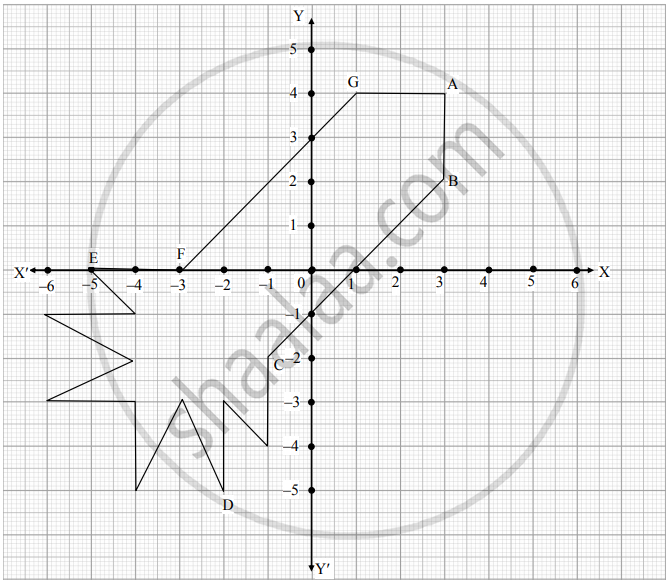Advertisements
Advertisements
Question
Let ABCD be a square of side 2a. Find the coordinates of the vertices of this square when A coincides with the origin and AB and AD are along OX and OY respectively.
Solution
The distance between any two adjacent vertices of a square will always be equal. This distance is nothing but the side of the square.
Here, the side of the square ‘ABCD’ is given to be ‘2a’.
Since it is given that the vertex ‘A’ coincides with the origin we know that the coordinates of this point is (0, 0).
We also understand that the side ‘AB’ is along the x-axis. So, the vertex ‘B’ has got to be at a distance of ‘2a’ from ‘A’.
Hence the vertex ‘B’ has the coordinates (2a, 0).
Also, it is said that the side ‘AD’ is along the y-axis. So, the vertex ‘D’ it has got to be at a distance of ‘2a’ from ‘A’.
Hence the vertex ‘D’ has the coordinates (0, 2a)
Finally, we have vertex ‘C’ at a distance of ‘2a’ both from vertex ‘B’ as well as ‘D’.
Hence the vertex of ‘C’ has the coordinates (2a, 2a)
So, the coordinates of the different vertices of the square are
A(0,0)
B(2a, 0)
C(2a, 2a)
D(0, 2a)
APPEARS IN
RELATED QUESTIONS
Prove that the points (3, 0), (6, 4) and (-1, 3) are the vertices of a right-angled isosceles triangle.
If A(–2, 1), B(a, 0), C(4, b) and D(1, 2) are the vertices of a parallelogram ABCD, find the values of a and b. Hence find the lengths of its sides
The three vertices of a parallelogram are (3, 4) (3, 8) and (9, 8). Find the fourth vertex.
If G be the centroid of a triangle ABC, prove that:
AB2 + BC2 + CA2 = 3 (GA2 + GB2 + GC2)
In what ratio is the line segment joining (-3, -1) and (-8, -9) divided at the point (-5, -21/5)?
Prove that the points A(-4,-1), B(-2, 4), C(4, 0) and D(2, 3) are the vertices of a rectangle.
Find the ratio in which the point (-1, y) lying on the line segment joining points A(-3, 10) and (6, -8) divides it. Also, find the value of y.
ABCD is a rectangle whose three vertices are A(4,0), C(4,3) and D(0,3). Find the length of one its diagonal.
The co-ordinates of point A and B are 4 and -8 respectively. Find d(A, B).
If the point P(x, 3) is equidistant from the point A(7, −1) and B(6, 8), then find the value of x and find the distance AP.
If (a,b) is the mid-point of the line segment joining the points A (10, - 6) , B (k,4) and a - 2b = 18 , find the value of k and the distance AB.
If the vertices of a triangle are (1, −3), (4, p) and (−9, 7) and its area is 15 sq. units, find the value(s) of p.
Find the value of k, if the points A(7, −2), B (5, 1) and C (3, 2k) are collinear.
If three points (0, 0), \[\left( 3, \sqrt{3} \right)\] and (3, λ) form an equilateral triangle, then λ =
If points (a, 0), (0, b) and (1, 1) are collinear, then \[\frac{1}{a} + \frac{1}{b} =\]
If the centroid of the triangle formed by (7, x) (y, −6) and (9, 10) is at (6, 3), then (x, y) =
If points A (5, p) B (1, 5), C (2, 1) and D (6, 2) form a square ABCD, then p =
The distance of the point P(2, 3) from the x-axis is ______.
If the perpendicular distance of a point P from the x-axis is 5 units and the foot of the perpendicular lies on the negative direction of x-axis, then the point P has ______.
Ryan, from a very young age, was fascinated by the twinkling of stars and the vastness of space. He always dreamt of becoming an astronaut one day. So, he started to sketch his own rocket designs on the graph sheet. One such design is given below :

Based on the above, answer the following questions:
i. Find the mid-point of the segment joining F and G. (1)
ii. a. What is the distance between the points A and C? (2)
OR
b. Find the coordinates of the points which divides the line segment joining the points A and B in the ratio 1 : 3 internally. (2)
iii. What are the coordinates of the point D? (1)
